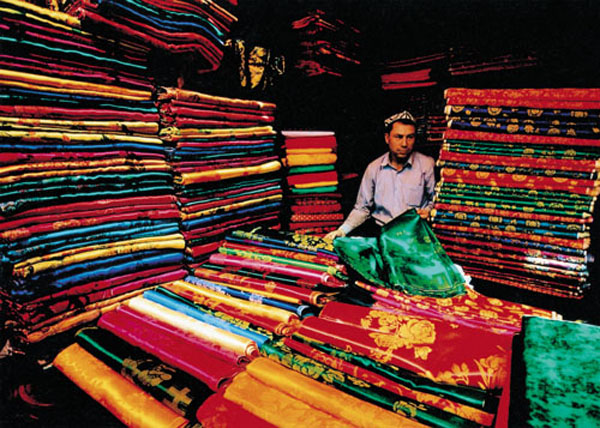Join-in Group Silk Road China Tours
About Us | Contact us | Tourist Map | Hotels | Feedback
Facts about Silk

Overview:Sericulture covers a circle of the cultivated and raised stages of silk produce under controlled conditions: moth egg - silkworm - pupae & cocoon - moth; until the cocoons reach the filature.
Silk is a natural protein fibre that can be woven into textiles. The protein fibre of silk is composed mainly of fibroin and are produced in different colors by several insect species.
Silkworm Bombyx mori
Generally only the silk of moth caterpillars certaining insect larvae to form cocoons has been used for textile manufacturing. The best-known type of silk is obtained from the cocoons of the larvae of the mulberry silkworm Bombyx mori reared in captivity (sericulture), but not the silk produced by various arthropod and arachnids such as spiders.
Silkworm Cocoon
The cocoon is made of a thread of raw silk from 300 to about 900 meters (1,000 to 3,000 feet) long. The fibers are very fine and lustrous, about 10 micrometers (1/2,500th of an inch) in diameter. About 2,000 to 3,000 cocoons are required to make a pound of silk (about 0.4 kg). At least 70 million pounds of raw silk are produced each year, requiring nearly 10 billion pounds of cocoons.
More than 90 percent of silkworm cocoon are cultivated to produced in white color. But now some special silkworm species are raised to produce cocoon in yellow, pink and blue colors, not dyed ones.
Sericulture
A variety of wild silks, produced by caterpillars other than the mulberry silkworm, have been known and used in China, South Asia, and Europe since ancient times. However, the scale of production was always far smaller than that of cultivated silks.
Moreover, commercial silks mostly originate from cultivated silkworms due to wild cocoons are not easy to be collected and stripped from pupae; of varieties in colour and less uniform in texture; and silk thread is not strong enough to unravel continuously and not easy to dye, with mineral on the surface.
Thus the most economically important primary silk producer is the larva or caterpillar of the domesticated silkmoth, Bombyx mori (silkworm of the mulberry tree in Latin). A silkworm eats the leaves of mulberry tree and Osage Orange, but white mulberry leaves is its preferred food. It is entirely dependent on humans for its reproduction and does not occur naturally in the wild.
Sericulture, the practice of breeding silkworms for the production of raw silk, has been underway for at least 5,000 years in China, from where it spread to Korea and Japan, and later to India and the West. The silkworm was domesticated from the wild silkmoth Bombyx mandarina which has a range from northern India to northern China, Korea, Japan and far the eastern regions of Russia. The domesticated silkworm derives from Chinese rather than Japanese or Korean stock.
Sericulture covers a circle of the cultivated and raised stages of silk produce under controlled conditions: moth egg - silkworm - pupae & cocoon - moth; until the cocoons reach the filature.
Silk Reeling Process
1) Once the cocoons reach the filature operations they are sorted by color, size, shape and texture. They usually range from white and yellow to grayish.
2) After the cocoons have been sorted, they have to be boiled in water, while they are still intact, for 5 minutes while they are being turned gently.
3) They are then taken out of the water and a dissecting needle is used to start picking up the strands. Once a single strand is found that will come off easily it has to be wound around a pencil. This is how the cocoon is loosened so that it can be unwound in 1 continuous thread, which are collected into skeins. The process is called "reeling".
Since the thread is too fine for commercial use, between 3 and 10 strands then have to be reeled together to produce the desired diameter of raw silk. This is known as "reeled silk." It will take 3,000 cocoons to make just 1 pound of this type of silk.
Silk Uses & Industry
In China, silk farming and making was originally restricted to women and maily used as luxury clothing products for the members of the imperial family. Later, it gradually extended to other classes of Chinese society. Silk began to be used for decorative means and also in less luxurious ways: musical instruments, fishing, and bow-making. Peasants did not have the right to wear silk until the Qing dynasty (1644–1911).
Silk's absorbency makes it comfortable to wear in warm weather and while active. Its low conductivity keeps warm air close to the skin during cold weather. It is often used for clothing such as shirts, ties, blouses, formal dresses, high fashion clothes, lingerie, pajamas, robes, dress suits, sun dresses and Eastern folk costumes. Silk's attractive lustre and drape makes it suitable for many furnishing applications. It is used for upholstery, wall coverings, window treatments (if blended with another fiber), rugs, bedding and wall hangings. While on the decline now, due to artificial fibers, silk has had many industrial and commercial uses, such as in parachutes, bicycle tires, comforter filling and artillery gunpowder bags.
Top Ten Cocoons (Reelable) Producers in 2005
Country Production (Int $1000)
People's Republic of China 978,013
India 259,679
Uzbekistan 57,332
Brazil 37,097
Iran 20,235
Thailand 16,862
Vietnam 10,117
Democratic People's Republic of Korea 5,059
Romania 3,372
Japan 2,023


